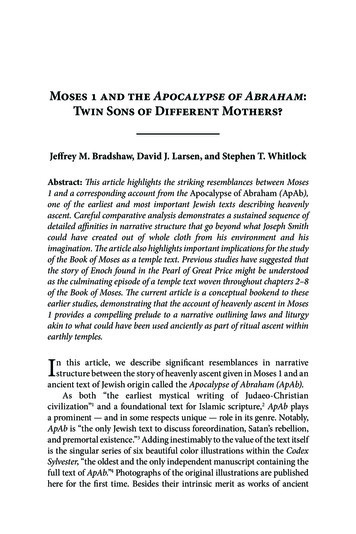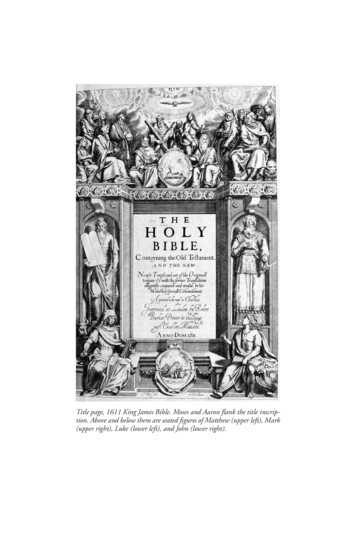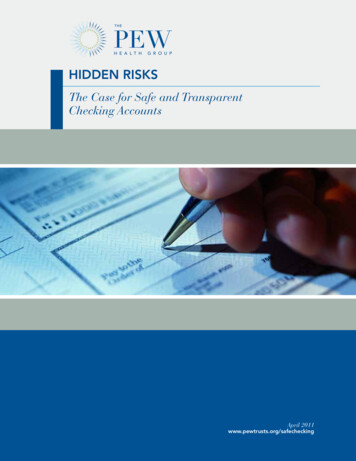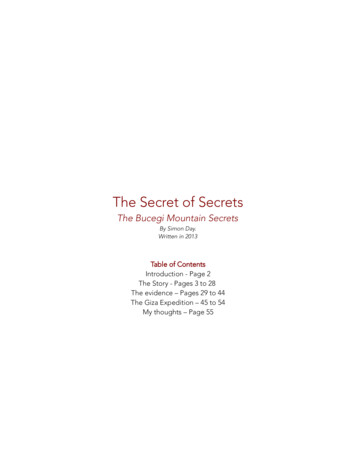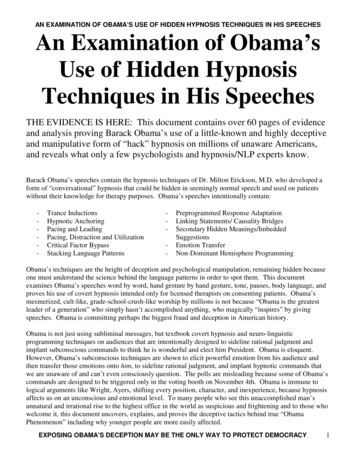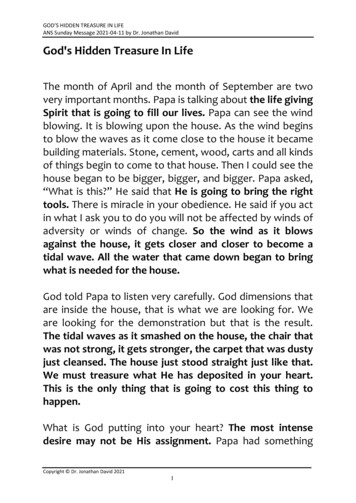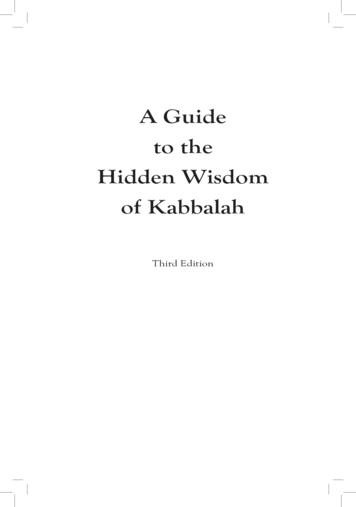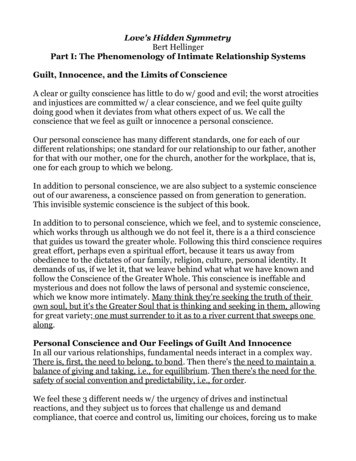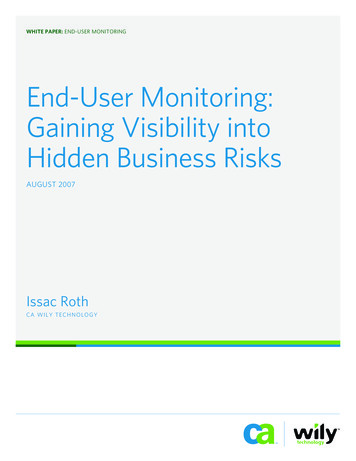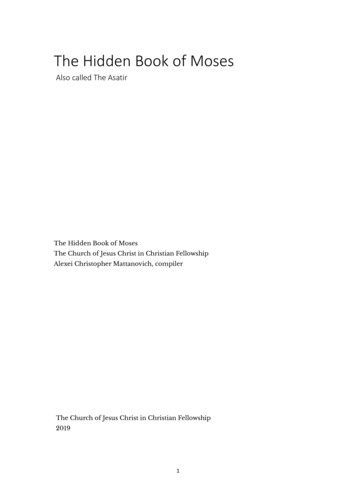
Transcription
The Hidden Book of MosesAlso called The AsatirThe Hidden Book of MosesThe Church of Jesus Christ in Christian FellowshipAlexei Christopher Mattanovich, compilerThe Church of Jesus Christ in Christian Fellowship20191
ISBN:The Church of Jesus Christ in Christian FellowshipPost Office Box 1503Miamisburg, Ohio, 45342www.CJCCF.org2
ContentsThe Hidden Book of Moses . 12019 Preface .4Original Introduction. 5The Hidden Book of Moses . 8Chapter 1 . 8Chapter 2. 9Chapter 3. 11Chapter 4 . 12Chapter 5 . 14Chapter 6 . 15Chapter 7 . 17Chapter 8. 18Chapter 9 . 20Chapter 10 . 21Chapter 11 . 24Chapter 12 . 253
2019 Preface“Abraham saith unto him, They have Moses and the prophets; letthem hear them.” -Luke 16:29 KJVOf the many great mysteries posed by the bible, the attitude of the Jewstoward the Samaritans is not one. Perhaps no other explanation need be sought asto why the proceeding work was not considered for inclusion in the HebrewCanon of scripture, notwithstanding their having preserved the oldest manuscriptof the Torah available for centuries. Had relations been better, we all may havegrown up revering the present work. It is therefore a delight to find the diamondthat they overlooked.I have polished the present edition from the translation of Moses Gaster, whoadmittedly passed on the title "Secret Book of Moses" despite it representing somemanuscripts on the basis that it doesn't quite fit the genre of some other booksbearing a similar title. It is clear enough, however, from the vagueness of the title'sEnglish translation that it represents a secret work or a work of secrets.Considering the recent publication of the Sealed Book of Moses, the Hidden Bookof Moses appears the most appropriate, as it will no doubt be compared with andread alongside that work.In presenting this work to the Latter Day Saints, I take especial delight inpointing out the similarities with the Sefer HaYashar (Book of Jasher) and theJoseph Smith Translation of Genesis (Book of Moses). Students of these otherworks will enjoy the expanded narrative these and other works create. I won'tspoil all the surprises by pointing them out. Not to be overlooked is thesignificance of the covenant that accompanies the reception of the Clothes ofAdam, and its relevance to the Temple Endowments of the Saints. Students of therecently published Book of Remembrance of Adam and Eve revealed to DavidFerriman will find it especially significant.I'll close this short introduction with some words from its original translatormore than a century ago, discussing not only the title, but the antiquity andauthorship ascribed, as the work is so old the language can no longer translate itstitle, and admonish you to do as the Lord commanded and "study it out in yourmind and in your heart and ask if it be right."In the Name of the All Merciful.- Alexei Christopher Mattanovich.4
Original IntroductionThe book is called by the Samaritans the "Asatir," or, as it should have been,"Astir." I have translated this title "The Secrets of Moses,” thus translating theSamaritan word "Asatir," so pronounced by the Samaritans, in order todistinguish it at once from the other books ascribed to Moses, such as the"Apocalypse" or the "Assumption of Moses." The Samaritans themselves nolonger understand the title, and were unable to enlighten me in spite of frequentquestioning, but they at the same time emphatically repudiate the notion that thetitle may be of Arabic origin.The word is one which has not been taken by them into their language; itoccurs neither in their liturgical poems nor in any other book with which I amacquainted, although they are quite familiar with the Hebrew parallel form foundin the passage in Deut. 31:18 [And I will surely hide my face in that day because ofall the evil that they have done, because they have turned to other gods], to whichthey attach overwhelming importance. The fulfilment of the threat expressed bythat sentence in the Bible, marks according to them the starting point of theFanuta, the Hiding of God's presence. The Hebrew word has not been retained inits Hebrew form even in the Samaritan Targum to that passage. But in the case ofthe present book, they have evidently retained the very old name, the truemeaning of which they have since forgotten. It is unquestionably the primitiveHebrew name for that literature which has since become known under the twoGreek names of Apocryphon [Secret Book] and Apocalypse [Revelation], bothmeaning something hidden or something revealed in a secret form. A narrowermeaning has been attached to the word "Apocryphon," inasmuch as it has beengiven to a set of books not received in what is called the Canon of the JewishBible.Without entering upon any discussion as to the meaning of the Canon of theJewish Bible, whatever may be understood by it, it is clear that it cannot beapplied to any Samaritan writing, since the Samaritans have only the Pentateuch,and outside this the Book of Joshua and some fragments of Judges and Samuel.These latter are treated by them as profane history. The use of the title"Apocryphon," therefore, would have been misleading, and as for "Apocalypse," itcould only be applied to the two last chapters, which deal with propheciesconnected with the very last hours of Moses upon earth. I have, therefore, asmentioned before, chosen the title "The Secrets of Moses" in preference to anyother, for it agrees much more closely with the character of this book; moreover,"Secreta Moysi" ("Secrets of Moses") appears as a title in one of the old lists ofbooks excluded from the Canon by the Church (see Charles, "The Assumption ofMoses," London 1897, p. XV). It is not unimportant to mention that in the Hebrewliterature a book has been preserved, to which reference will be made later on (p.52), under the title of "The Secrets or Mysteries of Rabbi Simeon ben Yochai." It isa real apocalypse, and contains prophecies concerning the end of time andvarious events connected therewith. The Hebrew name of it is "Nistarot," which isprecisely of the same root as the Samaritan form of "Asatir."From the contents, and from the fact that it is ascribed to Moses, the bookmight also be described as pseudepigraphic. True, it is nowhere in the textexpressly stated that Moses wrote it, but his authorship is assumed by the title,and by the tradition still alive among the Samaritans, although in quoting thebook, as will be seen later on (p. 137, 140) the various Samaritan writers quote only"the Master of the Asatir," or the "Author of the Asatir" (Baal Asatir). They leave itundecided as to whether Moses actually wrote it, or whether it is a traditionhanded down from Moses. Thus the Asatir belongs to the large number ofpseudepigraphic writings ascribed to Moses. It differs completely however from5
the others, inasmuch as it is the only one that starts from Adam and finishes withthe Death of Moses. It thus covers the whole of the Pentateuch. The Book ofJubilees carries its story from Creation to the Exodus. The so-called Apocalypseof Moses is in reality an Adam Book. It contains only the story of the going out ofParadise by Adam and Eve, the various incidents connected with the first man,and closes with the death of Adam and Eve. Another is the "Assumption" or ratherthe "Testament" of Moses, which is limited exclusively to the last days of Mosesand closes with a prophecy.The reason why an Adam Book should have been called "The Apocalypse ofMoses" has hitherto remained obscure, as no reference to Moses is found in anyof the texts, neither in the Greek, Latin, Slavonic, Arabic nor Ethiopian, nor evenin the Syriac Cave of Treasures, which already goes beyond the more limitedscope of the others. In the light of the Asatir, this difficulty is now removed, sinceit explains the reason for that title, as the text here begins with the history ofAdam and Eve and finishes with the Death of Moses. The "Apocalypse" may,therefore, have originally belonged to a similar full compilation. In fact, the"Apocalypse" agrees in the main with the first chapters of our book ascribed toMoses (cf. p. 115). From this the "Apocalypse" has then been detached, but retainedthe old title of the whole book.The Asatir, then, is accepted by the Samaritans as a book of Moses. Althoughthose who made copies for me from the older original MSS. differ amongthemselves in the wording of the title, still they are unanimous in ascribing it to"our Master Moses." So it appears also in the Arabic paraphrase, and in the"Pitron" (Commentary). Moreover, to the questions which I put to the SamaritansI received the unequivocal reply that of course the book was written by Moses,and although it did not enjoy the same authority as the Law, none the less thefacts which were related in the book were all true and reliable. The old traditionhas thus been preserved unaltered down to our very days.As Moses had written the Law, why should he not have added another bookof explanatory tales which completed his narrative and did not affect the Law?The Asatir keeps free of every legal prescription. The people, no doubt, believedthat Moses did not limit his work to the Pentateuch. The Jewish tradition goesfurther. The whole Oral Law is said to have been developed by Moses in additionto the written and not a few very ancient legal prescriptions are describeddistinctly as Laws (Halafra) given by Moses from the time of Sinai. In the Bibleitself a psalm is indeed ascribed to Moses. Among their oldest prayers theSamaritans have one ascribed to Moses and also one to Joshua, the former, savefor a few words, consisting of verses from the Pentateuch. No wonder that tothem many a legend connected with the narrative of the Pentateuch should alsohave been the work of Moses. Thus we have in our Asatir a book genuinelybelieved by the Samaritans to be a work of Moses, the only man acknowledgedcapable of writing such a book and foretelling the future.That the book was held in very high esteem by the Samaritans, and treatedalmost as a sacred book is proved by the fact that it has exercised great influenceon Samaritan literature, as will be shown later on (p. 134) as well as by anotherfact, which appears to be very simple, and yet is of great significance. Anyoneacquainted with Samaritan MSS. will notice that no profane book, whatever itscharacter may be, has ever been written on parchment. This material has beenreserved for books of a sacred or a semi-sacred character. It is only the Law, someancient prayer-book, or some very old philacteries, which were invested with aspecial character of sanctity, that have been written on parchment, and no otherwork. I have not found even a copy of Markah’s great poems on parchment Theonly exception is the Asatir, in a copy which is still preserved among theSamaritans of Nablus. From the end of the fifteenth century they have ceased6
using parchment because by that time the last remnant of the ashes of the redheifer prepared a few centuries previously, had come to an end. They weretherefore no longer in that state of levitical purity to handle and to prepare skinsfor sacred use. The fact that the old copy of the Asatir was written on parchment,shows the reverence with which this book was treated by the Samaritans, in thebelief that it was indeed a work of Moses.Moses Gasterfrom his introduction to the Asatir7
The Hidden Book of MosesAlso called The AsatirIn the name of God, we begin: This is the Asatir of our Master Moses upon whom be thepeace of God.Chapter 1Cain and Abel1. Praised be God who made the world and established Adam our ancestor andhis sons, Cain 1 and Abel, like unto him.2. And he gave to Cain the West and he gave to Abel 2 the North and the South. 33. And he gave Al'alah 4, the twin sister of Cain, to Abel to wife; and he gaveMakeda, the twin sister of Abel, to Cain to wife.4. And Cain dwelt in the midst of a city he built, which was called Nikl.5. And he divided the earth between himself and his sons in the month of Abib.6. And it came to pass after a number of days that Cain brought an offering andAbel a holy offering.7. And the first altar was in the precincts of the holy place between Luzah andMount Garizim: and the one was opposite the other.8. And it came to pass when Cain and Abel brought the offerings it was on thetwentieth of Nisan on the first day (Sunday).9. When Cain saw that his offering was not accepted, as it was not as he had beentaught by seeing the offerings of his father, he knew that it was unfit and hiscountenance darkened and his spirit became troubled.10. And on the day when Abel made his holy offering, twice God inclinedfavorably to Abel and to his offering, but he did not incline favorably to Cain andto his offering.11. At once when Cain perceived that He did not look favorably upon his offering,Cain was wroth and he returned to his land and he tarried four years withoutseeing Adam or Abel.12. And Eve loved Cain but Adam loved Abel. And when she saw that Cain did notcome, Eve took council with Adam and went to him and Abel went with her.13. And she found him removed to another place which was called afterwardsArfat.14. And this is the word spoken to Cain: Why are you wroth and why is thycountenance fallen? If you do well, do you not know you will be accepted and ifyou do not well, sin lies at the door and it shall all return upon your head.1Kain2Hebel3Yashar 1:144At’ala8
15 And it came to pass that Cain said unto his brother, Let us go into the field.And there he shed the blood of Abel.16. And when he shed the blood of Abel his spirit grew troubled and the earthgroaned for the Life of Abel and the seas were moved and the sun was dimmedand the moon darkened.17. And Adam was frightened with a great fear on that day as on the day on whichthey plucked the fruit and were driven from the Garden.18. And Adam lived in the country of Hohmata which is called Sifra 5 in the Bookof the Wars of the Lord.19. And he saw the planets (horoscope) of the days: and seven were fighting oneanother. And he saw that one of them was no more.20. And he removed and dwelt in Badan. And he counted thirty years to whenCain had killed Abel on the 16th of Tebet.21. Adam was created on Friday. And Adam and Eve tarried in the garden eightdays and he did not know Eve. And their minds were turned by the word of theserpent.22. And after the death of Abel, Adam separated himself one hundred years. Andafter that he knew his wife and she begat Seth.Chapter 2The First Ten Generations1. In the days of Seth, Cain went to the East where he had a town built unto Enochhis son whose name was Antokia. And Cain ruled one hundred years over the seasand over the dry land.2. And Seth begat Enos; and he built a town whose name was Pilonah in the nameof Enos.3. And Enos begat Cainan and Seth built a town and called it Damascus in thename of Cainan.4. And Cainan begat Mahalaleel and he built a town whose name was Atrot Shfim.5. And Mahalaleel begat Jared and he built a town whose name was Ja'azer.6. And Jared begat Enoch and he built a town whose name was Salem the Great.7. And when Enoch was thirteen years, he learned the Book of Signs which wasgiven to Adam. And these are the twenty-four precious stones, twelve for the timeof Divine Favour and twelve for the chosen heads of the sons of Jacob and to thedescendants of the servants of the high God.8. Meanwhile children were born to Cain in various places and he roamed aboutthe world in tribulation, until Cain begat Enoch and Enoch begat Irad and Iradbegat Mahujael and Mahujael begat Methusael and Methusael begat Lamech.9. In the fourteenth year, Lamech went from Hanohiah and built Anah and Nisahand Adah.Sifra, so pronounced by the Samaritans, and identified with Sichem, Samaritans take it to mean"ancient mount," i. e. Mt. Garizim. Samaritan Arabic omits "Hohmata" and "Book of Wars of the Lord,"and identifies Sifra with Nablus. Meshalma f. 1 2Qa. explains Sifra as "Shechem which had then not yetbeen built." B. of Jubilees Ch. III. 32: Adam born and died in Elda.59
10. And he killed as Cain did, and he built a place of worship whose name wasPadrai Tns.11. And when Adam went up to Rechoboth 'Ir, Lamech made golden imagescalled "lefis'i ulehaburati" (to my pain and to my wound).12. After that Adam started reading Nisis [the Book of Signs] before his sons.13. And when Enoch heard it, he prayed unto God and he was sixty five years old.And Enoch walked with God.14. And he rebuilt the altar of his forefather Adam.15. And he begat Methuselah and Methuselah Lamech and Lamech Noah in (themonth of) Nisan.16. And on the fourth day of his birth was seen a sign in the middle of the heavensand all the inhabitants of the world were frightened and theycame to Adam.17. And Adam arose in the height of his wisdom and he foretold the Flood, and healso proclaimed the statement that so long as Enoch was alive it would nothappen.18. And Adam was comforted by beholding the Prince and seeing his Children.19. And when Noah was weaned Lamech brought him to Adam to Bispara (Sifra)and Adam said, This will comfort us for he was good (perfect) from his birth.20. And Lamech built a town in his name and its name was Rifat which is Gibeon,which is situated on the south of the sanctuary of the Mount Garazim.21. And Lamech begat six sons. Tubal Cain was then born [through whom] he(Lamech) killed Cain.22. Jubal built Meseda which is called Rabta.23. Jabal built Kenaz which is Nisbor.24. Tubal Cain built Skips whose name is Albasra. He forged all manner of brasswork.25. Adam taught these. He taught Lamech one hundred and eighty years in theBook of Truth (i.e. the Law).26. His son [Seth] learned (ruled) one hundred and five years.27. Enos learned (ruled) eight hundred and five years.28. Cainan learned (ruled) nine hundred and ten years.29. Mahalaleel learned (ruled) eight hundred and ninety five years.30. Jared learned (ruled) eight hundred and forty seven years.31. Enoch learned (ruled) three hundred and sixty five years.32. On the day when Enos died came all the children of Adam to Sifra to hearAdam lament over him.33. On the fourth Enos died and he was carried to Sifra.34. And they wept over him, Adam and Seth and Enoch and Cainan andMahalaleel and Jared and his son Methuselah who was living in Badan.35. And they tarried with the weeping until the news reached Ahidan the son ofTubal Cain who was living in Hebron, and he was the head of the army ofCainites.36. And he had learned there in the Book of Signs before Adam.10
37. And when they came, they asked Adam that he should read to them the Law(nims) and he read it.38. And Enos was buried in the neighbourhood of Mount Garizim in the placewhich is called Jskr.39. It is called Mount Ebal where they hid Enos. And there are built in it manytombs.40. As Adam had said, This is the place of worship for the God of the world andabove it is the Gate of Heaven.41. For the fire does not touch those who are buried in a distance of two thousandcubits round about Mount Garizim. This is called the Shelter for the Fugitive, orthe Rock of Salvation.42. And Methuselah learned (ruled) seven hundred and twenty years.43. And Lamech learned (ruled) six hundred and fifty-three years.44. And Noah learned (ruled) six hundred years, and he read in the Book [ofSigns] which Adam taught him.Chapter 3Ahidan1 . And as the death of Adam drew near, then he bethought himself of the wordsAnd thou shalt surely die. And these are the days of Adam: nine hundred andthirty years.2. And all his children came to him to Badan.3. And he commanded them to carry him to 'Eyul Mth which is the valley ofHebron, which means place of joining,4. Which he had seen in his vision as having been made for the gathering of therighteous generations created on the day in which the tree of knowledge wasplanted.5. And this was that the saying For surely thou wilt die may be fulfilled.6. And there are three divisions in it, one for those who went out of the Garden,one for those who went out of the Ark and one for those whocame of the circumcised of the flesh.7. And this was called Machpelah, meaning manifold.8. And Noah settled in the place of Adam after the death of Adam.9. In seven years he learned the three Books of Creation: the Book of Signs, theBook of Astrology, the Book of the Wars which is the Book of the Generations ofAdam.10. Who is like unto thee among the mighty ones, O God.11. Who is like unto thee the God of the first ones and He who declares therighteousness of the latter ones. The Lord is one! He helped Noah.12. And all the sons of Adam grew numerous and powerful.13. And Ahidan, the son of Barad, the son of Tubal Cain, started and built Zionwhich is called Gifna (i. e. house of leprosy) which is Beth Machtesh (i. e. house ofshame).11
14. And he placed there a stone suspended (in the air) for worship like that in thetown which is called Adrms which is on the place where Adamhad bowed down [in worship] for the first time when he was driven out of theGarden.15. And that is the rock in whom they confide, the rock upon which they relied.16. And the evil increased six hundred years, and they turned away and yet theLord did not cause Fanuta to happen.17. But at the end of the generation when turning away and oppression increased,the world was full of men.18. And Ahidan begat a son and called him Asur.19. And he built Srs a place called Zion Telah (the hanging rock of Zion) and hegave it to him.20. And he sent and brought Gifna the daughter of Na'amah and brought herfrom Babel, who was one of the wicked worship of Lamech. And he gave her as awife to Asur; and he made a high tower21. And it rested upon four statues, one of gold, one of silver, one of copper, andone of olive wood.22. And he made a likeness of the sun and the moon of crystal and he put into thesun a golden luminous cup.23. And he put inside the moon a precious stone (shoham).24. And he said unto Gifna, Behold, let thy worship begin here.25. And Gifna appointed quickly four hundred servants and twenty ministers.Mighty is the holiness of the proclamation of faith on the rod ofAdam which is called the rod of God.26. And he made an open nigug in such wise as is called fhgl (i.e. dome or cupola)which when the wind passed through it from the four corners emitted a sound.27. And it lasted one hundred and ten years. And Asur begat a son from Gifna andhis name was Itanu.28. And Itanu begat a son and called him Shrikh.29. And when Gifna called the sun and the moon which Ahidan had made, theywalked with her.30. And when she did this, the people wished to worship them and the worldbecame evil and all flesh corrupted its way upon it.Chapter 4Noah1. And Noah left Rift and he dwelt in the mountain called 'Adr Shgg. This is theplace of the Ark.2. And God announced to him the knowledge of the flood and Noah started toexamine the Book of Signs, and Noah saw therein the obliteration of (the childrenof) Adam, and the protection of those who were to go into the Ark.3. And it came to pass at the time when he left [Rift] that there was a sign in theland.12
4. And Noah feared a great fear and he continued unceasingly with prayers andhymns one hundred years after he had begotten Shem, Hamand Japheth.5. And Shem took Shrit the daughter of Seth to wife.6. And Ham took Skh the daughter of Jared to wife.7. And Japhet took Mkisth the daughter of Lamech to wife.8. And when God commanded Noah to make the Ark, he made it and he finishedit on the tenth (twelfth ?) of the second month.9. And on the fourth (Wednesday) the earth became humid and broke open.10. And on the third (Tuesday) were opened the windows of Heaven. And on theseventh (Sabbath) was the end of the decree in the sixth hour of the night of theseventh day. And on the first [of the month] Noah went out of the Ark.11. And on the second he built an altar and he brought a holy offering.12. And God made with him the covenant of the rainbow on the seventh. AndNoah dwelt in 'Ith at the rising of the sun (East) in Babel and he started teachinghis children the principles of the confession of faith and the testimony.13. And after sixty two years he divided the earth among his sons Shem, Ham andJaphet.14. And to Shem he gave three portions and Japhet four and Ham four; [Shemdivided his portion, giving to] OElam, Ld, Aram and Ashur four portions andArpachshad one portion.15. And he gave the Book of Signs to Arpachshad, and the Book of Astronomy toElam and the Book of the Wars to Ashur.16. And he made them the foremost of all his sons.17. And Japhet divided the four portions, among Gomer, Magog, Maddai, Javan,Tubal, Meshech and Tiras each one portion.18. And Ham divided his land into four portions, Kush one portion and Misraimone portion, Put one portion and Canaan one portion.19. And when Noah had finished the division of the land by the astronomicalcalculation of the day, he found that there were still four thousand three hundredyears less seven years to come after the flood, of the six thousand from thebeginning of the creation and three hundred and seven since the flood.20. For from the beginning of the days of Creation there shall be 6,000 years,21. From the day of creation until the day of the visitation of the generations(through the flood) were one thousand three hundred and seven years.22. And from the day when Noah made the division among his children, until theday of the visitation of the generations were four hundred and ninety three years.23. And he divided his kingdom to his three sons in the year three hundred andtwenty.24. And Noah was on the day when he divided the land among his sons ninehundred and thirty years old.25. And he divided the land among his three sons on the tenth day of the monthof Elul.26. And then he sent proclamations to his sons that each one should go to hiscountry.13
27. And they took leave of him and Elam and Ashur went to the north of UrKasdim, which is called by them the place of Bab el Abwab (Gate ofGates),28. And which is on the border of Elam and Ashur.29. And Gomer and Magog were from Bab el Abwab and onwards.30. And Ld and Aram settled in Great Kutah whose name is Charassan the Blackwhich is called Algezirah in Afrikia (Phrygia).31. And Arpachshad settled in Ur Kasdim in Brktrs (Bactria ?) whose name isRomi. And Nimrod began to rule over all the children of Ham.32. And he built great Babel and they gathered themselves all together and theywent to build it, and Nimrod started to walk as a giant (i.e. great one) in the land.33. And Noah was nine hundred and forty five years old when the report of itreached Noah.34. But Shem his son was the one whom he had placed on the throne of thekingdom because he was the firstborn (i.e. heir).35. And Shem sent also to Elam, Ashur, Lud, Aram, and Arpachshad and theycame and built Niniveh and Calah, Rehoboth Ir, and Resen which is the largesttown.36. And the day drew near for Noah to die, so he sent and called Shem, Ham andJaphet, and they came to him to Salem the Great and built an altar and theybrought upon it thankofferings.37. And he completed his division and gave to Shem six and to Japhet six, and hemade Shem greater than Japhet.38. And Noah commanded them the keeping of peace and died. And his childrencarried him to Eyul Mth which is Hebron and they buried himin Eyul Mth and each one returned to his place.Chapter 5Nimrod1. And they gathered themselves in Babel when they journeyed from the East andthey found a plain in the land of Shinar and they dwelt there.2. And it was like [the plain of Sichem and a mountain like] Mount Garizim.3. And they said one to the other who beheld the land: Let us go up here and letus build a exalted building so that we may not be scattered abroad upon the faceof the earth.4. And they built a tower on top of the hill, and they placed upon it a lamp andthe light of it could be seen from the four sides.5. And they called it Sham and that is the word which is said, And let us make aSham.6. And He put an end to their building a
pointing out the similarities with the Sefer HaYashar (Book of Jasher) and the Joseph Smith Translation of Genesis (Book of Moses). Students of these other works will enjoy the expanded narrative these and other works create. I won't spoil all the su

